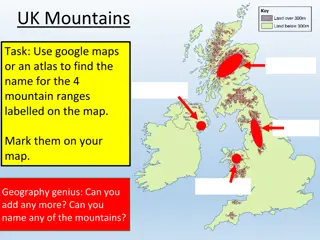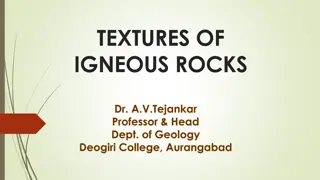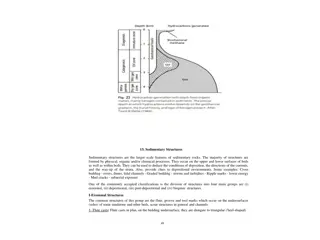Understanding the Rock Cycle: Igneous, Sedimentary, and Metamorphic Rocks
This educational material covers the formation and characteristics of Igneous, Sedimentary, and Metamorphic rocks. It includes details on the processes involved, such as heat melting rocks into magma, sediment formation through erosion and deposition, and the differentiation between intrusive and extrusive igneous rocks. The content also delves into the major elements found in igneous rocks and the significance of various geological processes in shaping the Earth's surface.
Download Presentation

Please find below an Image/Link to download the presentation.
The content on the website is provided AS IS for your information and personal use only. It may not be sold, licensed, or shared on other websites without obtaining consent from the author. Download presentation by click this link. If you encounter any issues during the download, it is possible that the publisher has removed the file from their server.
E N D
Presentation Transcript
+ Rocks and the Rock Cycle Notes Chapter 5.1 Igneous Rocks (112) Chapter 6.1 Sedimentary Rocks (134) Chapter 6.3 Metamorphic Rocks (145)
+Three types of Rocks 1. Igneous 2. Sedimentary 3. Metamorphic
+Igneous Rocks Form when lava or magma cools and minerals crystallize. Lava is magma that flows out onto the Earth s surface. Rocks must be heated to temperatures of 800-1200 degrees Celsius.
+Two causes of heat inside the Earth Early Molten Earth 1. From Earth s Molten Formation. 2. Decay (Breakdown of radioactive elements generate thermal energy.
+ This heat melts rock into magma.
+8 Major Elements of Igneous Rocks 1. Oxygen (O) 5. Magnesium (Mg) 2. Silicon (Si) 6. Calcium (Ca) 3. Aluminum (Al) 7. Potassium (K) 4. Iron (Fe) 8. Sodium (Na)
+2 Types of Igneous Rocks Intrusive Rock forms when magma cools and solidifies inside the Earth. Extrusive Rock forms when lava cools and solidifies outside the Earth s crust. (Intrusive = Inside) (Extrusive = Exits the Earth)
Sedimentary Rocks + pieces of rock that are moved by water, wind, and gravity. Sediments are small
+Sediments are made from two processes. 2. Erosion: 1. Weathering: Erosion is the process by which material is removed from a region of the Earth surface. Weathering is the breaking down of rocks, soil and Minerals through contact with the Earth's atmosphere, biota and waters. transport of sediments in the natural environment, and leads to the deposition of these materials elsewhere. Weathering occurs in situ, or "with no movement." It usually occurs due to transport by wind, water, or ice; the force of gravity; or by living organisms, such as burrowing animals, in the case of bioerosion.
+Formation of Sedimentary Rocks 1. Weathering and Erosion of sediment. 2. Deposition: when transported materials come to rest on the ground or sink to the bottom of a body of water, deposition occurs. 3. Lithification: the physical and chemical processes that transform sediment into rock. Lithos = stone Lithify= turn to stone.
+Two processes that cause lithification. 1. Compaction: The weight of overlying sediments forces the sediment grains closer together. 2. Cementation: Caused by mineral growth glues sediment grains together into a solid rock.
+Metamorphic Rocks Metamorphic Rocks form when preexisting rocks are exposed to increase in temperature and pressure. Root words: Meta = change Morphe = form Metamorphosis : a rock changes form while remaining a solid.
+When high temperature and pressure combine they change 1. Texture 2. Mineral composition 3. Chemical composition without melting.
+2 types of Metamorphic Textures 1. Foliated: Layers and bands of minerals in a rock. (stripes) 2. Nonfoliated:Composed mainly of minerals that form blocky crystal shapes. marble
+Rock Cycle The continuous changing and remaking of rocks. Two types of forces used in the Rock Cycle. rock cycle 1. Destructive: Destroying old rock. 2. Constructive: Making new rock.
+Rock Cycle Diagram assignment Create your own Rock Cycle Must include all three types of rock with examples. (use your book or notes.) Processes that form each. Label the forces as either constructive or destructive forces. Must be colored, neatness will be part of the overall grade























